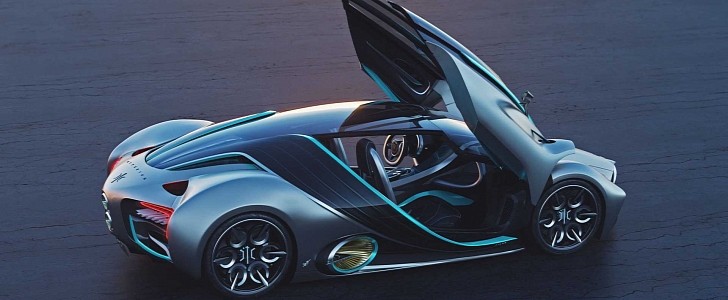Just when hydrogen fuel cells seemed dead and buried, Hyperion Motors decides to take the wraps off its HP-1 supercar. Will it be enough to save this once-thought alternative to battery-powered electric vehicles? Well, at this point, the more appropriate question would be just "will it be?"
Save for a few teasers, the Hyperion XP-1 came pretty much out of the blue. The company behind it has a nine-year history, but you'll be excused if you never heard anything about it until now. However, according to its credo and the voice of its CEO, Angelo Kafantaris, Hyperion is hell-bent on showing the world what a great fuel hydrogen can be.
In other words, it's trying to do what Toyota, Honda, or Hyundai failed before it. It may sound arrogant, but at least Hyperion's plan sounds a lot more solid. Instead of asking people to buy ugly, mundane cars that run on liquid H2, the California-based company bets on a much more exciting supercar.
Despite the short time since its reveal earlier this morning, it proved to be enough to split the audience over its design. The Bugatti Chiron vibes are hard to ignore, though the XP-1 has a more futuristic feel to it. It needs to, considering it has a bigger statement to make than Volkswagen's now famous hypercar.
If you were to ask us, we'd say we're still on the fence on its styling. The XP-1 definitely has a lot going for it, but it's also quite a busy design - to the point where your eyes struggle to find one area or one line to rest upon. It's flashy, and that's part of the company's strategy.
The performance of the XP-1 is where things get truly interesting. According to Hyperion, the supercar is supposed to travel 1,000 miles (1,600 km) before the carbon fiber tanks need refilling. That's double what the Lucid Air is expected to offer, but the thing with hydrogen-powered cars is that the infrastructure is even less prevalent than the one for BEVs. In other words, it might actually need that range if it wants to get anywhere.
Other specs include its listed top speed of "over 220 mph" (354 kph) and the ability to reach 60 mph (97 kph) from a standstill in under 2.2 seconds. The power output is kept secret, but we're told motivation comes from a pair of electric motors, confirming the XP-1 has an all-wheel-drive setup. It also has an incredibly low weight, especially when compared to regular BEVs: under 2,275 pounds (1,248 kilograms).
Hyperion Motors says it plans to build 300 of them at some point in 2022, and even though it makes no mention about its price, you can expect it to be pretty astronomical. Given the extensive use of exotic materials - carbon fiber, titanium - we're almost afraid to think of an actual sum.
Oh, and if you're not yet convinced the XP-1 might not be anything more than really dense vaporware, get a hold of this: the interior houses a 98-inch curved display. Good luck wrapping your head around that.
In other words, it's trying to do what Toyota, Honda, or Hyundai failed before it. It may sound arrogant, but at least Hyperion's plan sounds a lot more solid. Instead of asking people to buy ugly, mundane cars that run on liquid H2, the California-based company bets on a much more exciting supercar.
Despite the short time since its reveal earlier this morning, it proved to be enough to split the audience over its design. The Bugatti Chiron vibes are hard to ignore, though the XP-1 has a more futuristic feel to it. It needs to, considering it has a bigger statement to make than Volkswagen's now famous hypercar.
If you were to ask us, we'd say we're still on the fence on its styling. The XP-1 definitely has a lot going for it, but it's also quite a busy design - to the point where your eyes struggle to find one area or one line to rest upon. It's flashy, and that's part of the company's strategy.
The performance of the XP-1 is where things get truly interesting. According to Hyperion, the supercar is supposed to travel 1,000 miles (1,600 km) before the carbon fiber tanks need refilling. That's double what the Lucid Air is expected to offer, but the thing with hydrogen-powered cars is that the infrastructure is even less prevalent than the one for BEVs. In other words, it might actually need that range if it wants to get anywhere.
Other specs include its listed top speed of "over 220 mph" (354 kph) and the ability to reach 60 mph (97 kph) from a standstill in under 2.2 seconds. The power output is kept secret, but we're told motivation comes from a pair of electric motors, confirming the XP-1 has an all-wheel-drive setup. It also has an incredibly low weight, especially when compared to regular BEVs: under 2,275 pounds (1,248 kilograms).
Hyperion Motors says it plans to build 300 of them at some point in 2022, and even though it makes no mention about its price, you can expect it to be pretty astronomical. Given the extensive use of exotic materials - carbon fiber, titanium - we're almost afraid to think of an actual sum.
Oh, and if you're not yet convinced the XP-1 might not be anything more than really dense vaporware, get a hold of this: the interior houses a 98-inch curved display. Good luck wrapping your head around that.






















